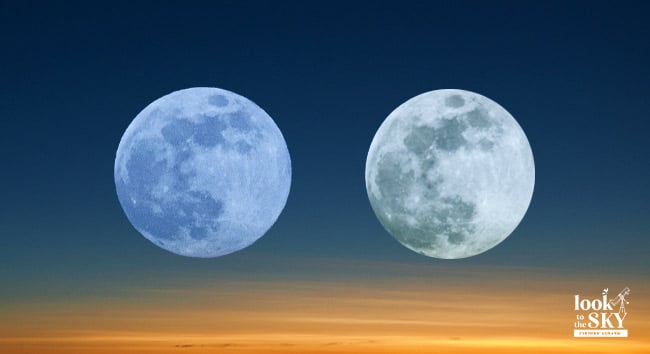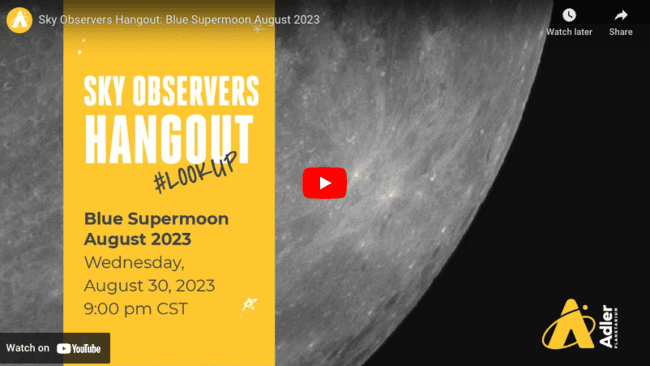When two full Moons appear in a single month, the second one is usually called a Blue Moon. However, there is proof that this popular definition may be a misunderstanding picked up by mainstream media in the 1940s! Learn about different definitions for a Blue Moon, when the next one will occur, superstitions, and ways to celebrate these special full Moons!
What Is A Blue Moon And Why Blue?
A Blue Moon isn’t actually blue in color. Though the Moon may appear to be blue due to atmospheric conditions on rare occasions.
The term “Blue Moon” is commonly attributed to William Shakespeare, who wrote from 1585 to 1613, though there are earlier references described in a religious pamphlet from 1528 (during The Protestant Reformation). Written by two Greenwich friars, William Roy and Jerome Barlow, the pamphlet criticized Roman clergy by noting that common people were expected to believe their every word, even if the clergy were to say something ridiculous, like the Moon is blue. Centuries later, a “Blue Moon” is still associated with something rare or uncommon, though not usually in such a derogatory sense.
For the longest time, nobody knew why the second full Moon occurring in a calendar month was designated as “blue.” One explanation connects it with the word belewe from Old English, meaning, “to betray.” Perhaps, then, the Moon was “belewe” because it betrayed the usual perception of one full Moon per month? That would make sense. (Fun fact: This naming does help to maintain the order of the other full Moons names—Strawberry Moon, Wolf Moon, etc.)
RELATED: When Is The Next Full Moon? Dates, Times, And Names
However writer Phillip Hiscock uncovered more about the origin of the term and published his findings in the March 1999 issue of Sky & Telescope magazine. Hiscock claims that the modern custom of naming the second full Moon of any month “blue” was based on a misinterpretation of the Maine Farmers’ Almanac (no relation to Farmers’ Almanac or FarmersAlmanac.com) by James Hugh Pruett in March 1946. This almanac’s actual definition didn’t have to do with how many full Moons were in one month but instead how many were in each season. There are normally three in each season, but when there are four, the third one is called “blue.”
Two Traditional Types Of Blue Moons
1) If there are two full Moons in a single calendar month, the second one is “blue” (known as a monthly blue Moon.) This occurs every 33 months on average. While this is the most popular definition for a Blue Moon, it may not be the truest.
2) If there are four full Moons in a single season; the third one is “blue” (known as a seasonal Blue Moon). This is the definition outlined in the almanac mentioned above.
A Third Type of Blue Moon?
3) If you have been following our Full Moon Horoscopes monthly series, you know that full Moons usually occur in a different sign each month. However sometimes two full Moons occur while the Sun is in a single zodiac sign, which creates an Astrological Blue Moon. For instance, the full Moons on June 21 and July 21 in 2024 both reached peak illumination while the Sun was in Cancer. According to this astrological rule, the Full Buck Moon on July 21 was “blue.”
Any questions? Contact [email protected]

When Is The Next Blue Moon?
- May 31, 2026 (monthly)
- May 20, 2027 (seasonal)
- August 24, 2029 (seasonal)
- August 21, 2032 (seasonal)
- May 22, 2035 (seasonal)
Previous Blue Moons
- August 30, 2023 (monthly)
- August 19, 2024 (seasonal)

Our friends at Adler Planetarium offered a free telescopic LIVE view of the Blue Moon Supermoon that occurred on August 30, 2023 at 9:36 p.m. EDT.
Blue Moon Color Symbolism
There are various legends associated with the Blue Moon, including how it may reflect sadness. In Eskimo folklore, for example, the “Blue Moon” is believed to result from the sadness of the Moon needing to keep his distance from his lover, the Sun, for fear of overshadowing her with reflected glory. Needing to be apart made this mythical Moon sad, and hence, blue.
In Medieval Europe, the Blue Moon was associated with devastation and disease, whether from plagues, natural disasters, famine, or other factors. This further connected the idea of sadness around this Moon. Because blue is a color associated with water, including tears and rain, it also bears this connection.
Yet not all blue references are sad. The color is also associated with protection, particularly from evil spirits, a strong belief in many Eastern European, Middle Eastern, and Asian cultures. Amulets are often blue to harness the protective nature of the color blue.
Other color meanings, particularly for blue, relate to nature. The blue hues of the sea and sky are considered unifying and tranquil, representing loyalty, trust, and faithfulness—a “true blue” friendship, for example.
On peculiarity of the color blue is its social association with masculinity. Astonishingly, this association is relatively new and while references to blue being a masculine color can be found as far back as the late 1800s, it wasn’t until the mid- to late 1900s that the blue/pink boy/girl associations became firmly fixed in gender associations. Previously, any color could be used for either boys or girls, and in fact, simple white was the most common color associated with babies of either gender based on the purity of christening robes and the ease of cleaning infant garments.
While no one source confirms the association of blue with boys, the color pairing was initially strongest as a traditional choice in France, which heavily influenced global fashion in the early 1900s. This could be how the gender/color pairings became so strict later in the century in many areas that looked to European designers as the height of fashionable attire.
Blue Moon Superstitions And Magic
Blue Moons are associated with a variety of superstitions and spiritual practices.
- They are thought to bring abundance and good fortune to those who gaze upon them.
- In some cultures, the Blue Moon is a special time to communicate with one’s ancestors, who may be more inclined to grant wishes or special favors during such a rare event.
- Turning a coin over in your pocket during a Blue Moon is believed to invoke good luck! Seeing dimes? Learn more.
- Picking berries or flowers (of any color) during a Blue Moon is believed to increase their magical potency.
How To Celebrate
There are fun ways that anyone can celebrate a Blue Moon, no matter what one’s spiritual beliefs or superstitions may be surrounding this rare extra Moon. Consider a meal using blue foods, such as blueberries (even better if they’re picked during the Blue Moon!), blue corn, blue cheese, or blue crab. Psst … check out our winning blueberry recipes here. Raise a toast with blueberry lemonade or blue curaçao (a Caribbean liqueur)!
A bouquet of blue flowers can be a beautiful tribute to a Blue Moon. Larkspur, cornflower, bluebells, clematis, columbine, hyacinth, periwinkle, and hydrangea are just a few blooms that come in remarkable shades of blue and would make lovely decorations or a centerpiece for a Blue Moon meal.
For a glittering touch of elegance, consider blue jewelry featuring sapphire (September’s traditional birthstone), blue diamonds, lapis lazuli (see below), blue topaz, tourmaline, aquamarine, turquoise, or other blue gems. Add even more significance to a blue jewelry piece with accents of Moonstone to specially commemorate this Moon.
Wearing blue clothes, decorating with blue, a blue nail polish manicure or pedicure, blue-themed crafts, or other fun options can all bring more celebration. And don’t forget to play the 1934 song “Blue Moon” by Richard Rogers and Lorenz Hart, or one of the covers by popular artists such as jazz singer Mel Tormé (1949), the king of rock-and-roll Elvis Presley (1954), romantic crooner Frank Sinatra (1961), or even the more modern due of Rod Stewart and Eric Clapton (2004)!
Can The Moon Ever Really Turn Blue?
On past occasions, usually after vast forest fires or major volcanic eruptions, the Moon has reportedly taken on a bluish or lavender hue. When dust and ash of a particular size—roughly one micron in diameter—are propelled high into the Earth’s atmosphere they will scatter yellow and red light from the color spectrum. This gives the Moon a faint bluish tinge so long as the phenomenon lasts (though the Moon itself never changes color). For example, when the Indonesian volcano Krakatoa erupted in 1883, as well as the eruption of Mt. Saint Helens in Washington state in 1980, atmospheric conditions created blue-colored full Moons. In 1980 there were two astronomical Blue Moons—in January and March—but the volcanic eruption was on May 18, missing a blue “Blue Moon” opportunity, and there were no astronomical ones in 1883.
Join The Discussion
Based on the information above, which definition do you prefer?
Share your thoughts with us in the comments!


We can’t leave out the best cover version of the song “Blue Moon.” It is by The Marcels.
It sure is!
I read about the actual definition of a ‘blue moon’ quite some years ago, and came to the conclusion then that any mistake that has persisted in the media this many years is unlikely to ever be corrected. There will always be a spate of articles and TV news stories clamoring about the ‘Blue Moon!’ any time we have two full moons in one month. Which isn’t actually that rare, by the way. Some years it even happens twice.
All the phases are special in their own right. Let’s observe them all!!!
We agree!! We hope to be shedding more light (or a lot less, haha) on New Moons next!
Every Blue moon is both seasonal & monthly. Every Blue season has blue moon months so every 2.5-3 years/ season /month is a Blue moon 3rd moon is Blue if there is 1& 2 x2
13 is the uninvited one . Unfriendly 13 is a Blue moon .
This is a brilliant article! Admittedly, I had always followed the two full moons in a calendar month rule. However, I had then heard some old lore (possibly Celtic because of the lore surrounding a Sidh Moon/ Faerie Moon which supposedly refers to the second New Moon in a month) which stated if a calendar year had 13 Full Moons, the last Full Moon (thus in December) was considered the Blue Moon.
Considering what one of the other comments said about the Full Moon having bluish overtones in winter – it kind of makes sense too. Old lore is fascinating! I love how stories & traditions develop, and I love researching the roots of long-held ideas.
Thank you!
The Original saying, “once in a Blue Moon” was in reference to the Full Moon that occurred on the Winter Soltice. Being the middle of Winter in the northern hemisphere it was cold, thus the color Blue. Now, the “Once in a Blue Moon” was a rough measure of time of 17 1/2 years between these events. The term today was twisted to the 2nd full moon in a month by the Star Gazer on PBS back in the seventies. It’s really just the 2nd full moon in a month.
Hi Rod, it seems your information conflicts with ours, which came from an astronomer, so we stand by it.
I always have and will continue to use the “twice in one month” definition. It’s what I’ve always heard since I was a boy. I never heard of the 4 in a season deal until just recently, and I’ve been a sky and starwatcher since the 60s
“I would rather err with Galen than proclaim the truth with Harvey.”
I really like the article. I appreciate the information. Your article information will be passed on. Great job!
Thank you, Jodie! We’re glad you found it informative.
Interesting. Always wondered where that expression originated.